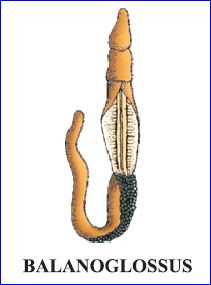 This is Online Notes on NCERT Chapter = 7 (DIVERSITY IN LIVING ORGANISMS) Part 4 of 9th class for preparation of CBSE BOARD Examination, NTSE etc.
This is Online Notes on NCERT Chapter = 7 (DIVERSITY IN LIVING ORGANISMS) Part 4 of 9th class for preparation of CBSE BOARD Examination, NTSE etc.Phylum 8 : Hemichordata
(i) Small group of marine animals
(ii) Cylindrical, bilateral symmetry, triploblastic
(iii) Coelom present
(iv) Gills for respiration
(v) Examples : Balanoglossus
Phylum 9 : Chordata
(i) Bilateral symmetry, triploblastic(ii) Coelom present
(iii) Notochord
(iv) Gills present at some phase of life
(v) Dorsal nerve chord
(vi) Post anal tail present at some stage of life, for example, present in humans in embryonic stages
(vii) Sub-divided into two :
(a) Prochordata
• Notochord at some stage of life
• Marine
• Examples : Herdemania, amphioxus
(b) Vertebrata
• Notochord converted to vertebral column
• 2, 3, 4 chambered heart
• Organs like kidney for excretion
• Pair appendages
• Examples : Humans (4-chambered), frog (3-chambered),
fishes (2-chambered)
Vertebrates are divided into five classes namely Pisces, Amphibia, Reptilia, Aves and Mammalia.
• Warm blooded organisms : These are organisms which
maintain same body temperature irrespective of outside
temperature. Example : Humans. Human’s body temperature
is approximately 37º.
• Cold blooded organisms : These are organisms which change
their body temperature as per surrounding temperature.
Example : Frog.
• Fishes are divided into two categories on the basis of
skeleton :
(i) Fishes with bony skeleton called bony fishes. Example : Tuna.
(ii) Fishes with cartilage skeleton called cartilaginous fishes.
Example : Shark.
(i) Pisces (Fishes)
• They are fishes living in water.
• Their skin is covered with scales or plates.
• They respire using gills.
• They have streamlined body and fins which help them to move in water.
• They are cold blooded and their heart has only two chambers.
• They lay eggs from which the young ones hatch out.
Some fishes have skeleton made of cartilage like Sharks, Rays etc. and some have skeleton made of bones and cartilage like Tuna, Rohu etc.
(ii) Amphibia (Amphibians)
• They are found in land and water.
• They do not have scales but have mucous glands on their skin.
• They are cold blooded and the heart is three chambered.
• Respiration is through gills or lungs. They lay eggs in water.
• Example : Frogs, Toads, Salamanders etc.
(iii) Reptilia (Reptiles)
• They have scales and breathe through lungs.
• They are cold blooded.
• Most of them have three chambered heart but crocodiles have four
chambered heart.
• They lay eggs with hard covering in water.
• Example : Snakes, Turtles, Lizards, Crocodiles etc.
(iv) Aves (Birds)
• They are warm blooded animals.
• They have four chambered heart.
• They breathe through lungs.
• They have an outer covering of feathers.
• Their two fore limbs are modified into wings for flying. They lay eggs.
• Example : Crow, Sparrow, Pigeon, Duck, Stork, Ostrich etc.
(v) Mammalia (Mammals)
• They are warm blooded animals.
• They have four chambered heart.
• They have mammary glands for production of milk to nourish their young ones.
• The skin has hairs and sweat glands. Most of them give birth to their young ones.
• Some of them lay eggs (like Platypus and Echidna).
• Example : Cat, Rat, Dog, Lion, Tiger, Whale, Bat, Humans etc.














0 Comment to "Notes on NCERT Chapter = 7 (DIVERSITY IN LIVING ORGANISMS) Part 4 => 9th class"
Post a Comment
Comment HERE, to know more about this topic.